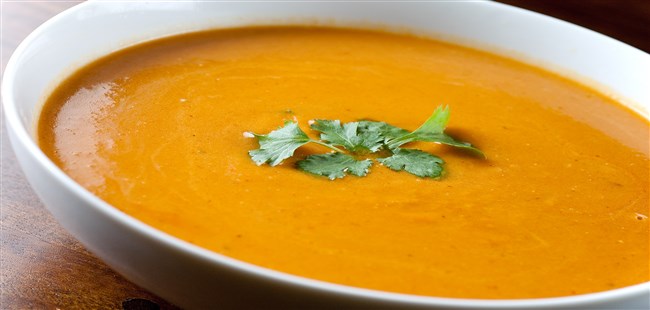Making your own soups, stocks, and sauces are rewarding, since you can make nutritious and inexpensive dishes that are far superior to anything you could buy, using simple, fresh ingredients and a few basic cooking skills.
Making Soups And Stocks: The basis of a good homemade soup is a flavorful stock. Bouillon cubes save time, but it is relatively easy and inexpensive to make your own stock using leftover vegetables or the bones from a roast. There is an infinite variety of soups that you can create, in your kitchen.
Making Soups
• Sweating vegetables: Before adding stock, cook vegetables first by “sweating” in a tightly covered pan with a little butter. Add a few tablespoonfuls of wine or dry sherry for extra flavor. Cook over low heat for one hour, shaking now and then to prevent sticking.
• Using lettuce leaves: Instead of discarding the large, tough outer leaves of lettuce, shred them like cabbage, and cook in a stock. Purée when soft, and stir in a little cream.
• Using leftovers: Make a quick vichyssoise with cooked potatoes. Fry an onion or a leek until soft, then purée it with the potato and vegetable stock. Add cream to taste.
Pureeing Vegetables
Using a ladle: To purée cooked vegetables by hand for adding to soups, put them into a large sieve over a bowl, and squash them with a ladle. This is quicker than using a wooden spoon for pressing and requires less effort.
Thickening Soups
Using a beurre manié: To thicken a soup quickly and easily, mix together equal amounts of butter and all-purpose flour to a thick paste. Drop small spoonfuls of the mixture into the hot soup, and stir over the heat until sufficiently thickened.
Using Stocks
• Cooking on low heat: To make a really rich, clear stock, simmer it slowly over very low heat. Boiling a stock tends to give a cloudy appearance.
• Reducing stock: To store cooked stock, reduce it first by boiling it in an uncovered pan until it is very thick and syrupy. The stock will then set when cooled, and this will keep longer than a liquid.
• Using leftovers: Add leftover vegetables, trimmings, or peelings to stock for flavor. Do not use potatoes, since they will make the stock cloudy.
Adding Variety
• Using spices: Stir mild curry powder into carrot or parsnip soup to add a warm flavor.
• Adding texture: Before puréeing vegetables for a soup, set aside a ladleful of the cooked, chopped vegetables to add texture to the soup.
• Crumbling cheese: Liven up creamed or canned soups by stirring in some crumbled blue cheese before serving.
• Making pistou: Crush three garlic cloves with 2 tbsp (30 ml) pine nuts, a handful of basil, and 2 tbsp (30 ml) olive oil. Stir the mixture into vegetable soups to taste.
Making Egg-Based Sauces
Sauces incorporating eggs are made either by creating a thick emulsion, as in mayonnaise or hollandaise or by gentle cooking, as in the case of custard or cream sauce. Egg-based sauces take longer to make than many other sauces, but their rich, creamy textures are unmatched.
Correcting Faults
• Adding ice: If you overheat hollandaise sauce, and it is just starting to curdle, stir in an ice cube to cool it quickly.
• Rewhisking hollandaise: To smooth a curdled hollandaise sauce, add it drop by drop to a spoonful of vinegar in a clean bowl, whipping hard until the sauce rethickens.
• Using egg yolk: If mayonnaise separates, beat a fresh egg yolk in a clean bowl, and whip in the mayonnaise drop by drop until the mixture thickens.
• Adding cornstarch: If a custard sauce begins to curdle, plunge the base of the pan into cold water, then push the sauce through a sieve. Whip a teaspoonful of cornstarch into the sauce, and reheat gently without boiling until thickened.
Making Mayonnaise
Reducing fat: For a white, low-fat mayonnaise, use whole eggs instead of just the yolks, or mix the mayonnaise with plain yogurt in equal parts.
Using a blender:Put all the mayonnaise ingredients except the oil into a blender. Run the machine, and add the oil in a thin stream until the sauce thickens. Then add any extra ingredients, such as watercress.
Making Hollandaise
Using a microwave: Heat 7 tbsp (100 g) butter in a large cup on High, and whip in two egg yolks and flavorings. Cook on Medium for one minute.
Avoiding Curdling
To make hollandaise sauce without a double boiler, prepare it in a bowl placed in a roasting pan containing simmering water. Make sure that the bowl is not directly above the heat source.
Making Other Sauces
There are numerous different types of sauce in addition to custard and the emulsions produced by traditional sauce-making methods. Flour-thickened mixtures are useful, and sauces made from simple purées, salsas, and cream reductions provide interesting alternatives.
Making Salsas
Salsas are an essential part of Mexican cuisine, adding powerful flavors and rich colors to simple meals. Saving time Place chilies, garlic, onions, tomatoes, and seeded peppers in a food processor. Pulse until finely chopped for a salsa cruda.
• Mixing fruits: Combine finely chopped fresh mango, pawpaw, and chilies to serve with grilled fish or chicken.
• Creating mild flavors: To reduce the strong flavors of raw garlic and onions, simmer for 5-8 minutes before use.
Working with Sauces :Adding cornstarch To thicken a smooth sauce, blend tsp (5 ml) cornstarch into tsp (10 ml) cold water, add to the sauce, and stir over moderate heat until thickened.
Correcting lumpy sauces If a sauce or gravy has become lumpy, pour it into a food processor, and process until smooth. Alternatively, press the sauce through a sieve.
Making purées Use smooth purées of vegetables such as peppers for colorful, simple, low-fat sauces. Grill the peppers to remove the skins, then purée in a processor.
Traditional Tip
Deglazing a pan: Add wine, stock, or cream to
the concentrated juices or sediment left in a roasting pan after cooking meat or poultry. Bring to a boil, and stir well.






